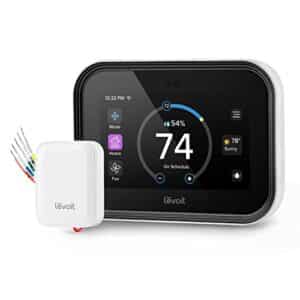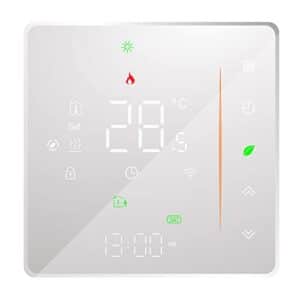What Does A Smart Thermostat Do?
Key Takeaways
- A smart thermostat allows for remote access and control, allowing homeowners to adjust temperature settings from anywhere using a smartphone, iPad, or computer.
- Smart thermostats have learning and adaptability features, automatically adjusting temperature settings based on user behavior and preferences.
- Smart thermostats can integrate with automation tools like smart speakers or virtual assistants, allowing for convenient and hands-free control through voice commands.
A smart thermostat is a device that uses technology and sensors to control the heating and cooling systems in a home. It goes beyond the capabilities of traditional thermostats by offering advanced features and connectivity options. In this article, we will explore the various functions and benefits of a smart thermostat.
Remote Access and Control
One of the key features of a smart thermostat is the ability to access and control it remotely. Using a smartphone, iPad, or computer, homeowners can adjust the temperature settings from anywhere. This means you can turn on the heat or air conditioning before arriving home, ensuring a comfortable environment upon arrival.
Learning and Adaptability
A smart thermostat learns your temperature preferences and habits over time. By analyzing your behavior, it can automatically adjust the temperature settings to meet your needs. For example, if you tend to lower the temperature at night, the smart thermostat will remember this and make the adjustment for you. This learning capability helps optimize energy usage and provides personalized comfort.
Integration with Automation Tools
Smart thermostats can integrate with other automation tools in your home. They can be connected to smart speakers or virtual assistants like Google Assistant, Siri, or Alexa. This allows you to control the thermostat using voice commands, making it even more convenient and hands-free.
Energy Efficiency and Cost Savings
One of the main benefits of using a smart thermostat is its energy-saving capabilities. By optimizing heating and cooling based on your habits and programming preferences, it can help reduce energy consumption and lower utility bills. Smart thermostats can save roughly 10% in electrical savings, making them an attractive option for homeowners looking to save money in the long run.
Advanced Features
Smart thermostats offer a range of advanced features that enhance their functionality. Some models come with touchscreen displays, allowing for easy and intuitive control. Others have built-in sensors to detect HVAC problems and provide alerts for maintenance or repairs. Additionally, smart thermostats can track energy use and provide insights into your consumption patterns, helping you make informed decisions about energy management.
Installation and Compatibility
Installing a smart thermostat involves turning off furnace power, replacing the existing backplate with the new thermostat, matching up the wires, and connecting it to the internet. While the installation process may require some technical knowledge, it is generally straightforward. However, it is important to ensure compatibility with your existing heating and cooling systems before making a purchase.
Brand Comparison
When it comes to choosing a smart thermostat, there are several brands and models available in the market. The Ecobee Smart Thermostat Premium is recognized as the best overall smart thermostat, offering features such as remote sensors, built-in smart assistants, and an air quality monitor. The Nest Learning Thermostat v.3 is another popular option known for its classic design and ability to learn user behavior. For those on a budget, the Amazon Smart Thermostat and the Nest Thermostat offer affordable options with different compatibility features. The Honeywell RTH6580WF is a basic and affordable smart thermostat that works well with various smart home devices.
Conclusion
A smart thermostat is a powerful device that can greatly enhance your home’s temperature control and energy efficiency. With features like remote access, learning capabilities, and integration with other automation tools, it provides convenience and customization to suit your lifestyle. While installation may require some technical knowledge, the long-term benefits of energy savings and cost reduction make it a worthwhile investment. When choosing a smart thermostat, consider factors like brand reputation, compatibility, and additional features to find the one that best suits your needs.
Related Websites:
FAQs:
Q: What is a smart thermostat?
A smart thermostat is a device that allows you to control and automate your home’s heating and cooling system using advanced technology. It offers features like remote access, energy-saving algorithms, and integration with other smart devices.
Q: How does a smart thermostat work?
Smart thermostats use Wi-Fi and smartphone apps to connect to your heating and cooling system. This allows you to remotely access and control your thermostat from anywhere. The benefits include the ability to adjust settings when you’re away, saving energy and providing personalized comfort.
Q: What are the energy-saving capabilities of a smart thermostat?
Smart thermostats have energy-saving features and algorithms that learn your preferences and schedule. They can adapt to your behavior, automatically adjusting temperature settings to optimize energy usage. This helps reduce energy consumption and lower utility costs.
Q: Can smart thermostats integrate with other home automation systems?
Yes, smart thermostats can seamlessly integrate with other smart devices and home automation systems. For example, they can work with voice assistants, smart lighting, and security systems. This provides a unified and automated experience, enhancing convenience and energy efficiency.
Q: What are some additional features of smart thermostats?
Smart thermostats offer advanced features like geofencing, which adjusts temperature settings based on your location. They may also have occupancy sensors to detect if someone is home or not. Additionally, they provide data tracking and usage reports, giving you insights into your energy consumption patterns.






